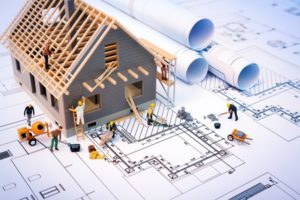
Columbia Builders creates beautifully designed homes that don’t compromise on durability! Learn about how our building methods protect against condensation.
There is more to the exterior design of a home than just a pretty façade. The building envelope seldom receives the attention it deserves. Given the issues of building resilience, durability, design, and client comfort, more single-family builders are leaning on performance standards to create high-performance, high-design home exteriors. It all starts with understanding a few important principles, namely how condensation can impact your home and how to control it.
Addressing Condensation Issues
Opposing exterior and interior temperatures create condensation where cold, warmth, and humidity meet, which turns vapor into droplets. Depending on the outside temperature, temperature difference, and relative humidity, these droplets may form on the siding, on the water-resistant barrier, on the back of the plywood, on the studs, and even on the drywall.
The location in the wall where this water will form depends on the dew point temperature. If the dew point is in the wall cavity, and the wall stays wet longer than it stays dry, all of the water-sensitive materials (wood framing, sheathing and/or drywall) can be structurally compromised. More worrisome and immediate, though, is the mold and mildew that thrives in such high-humidity conditions. Over a cold winter or hot summer, the moisture persists. Indoor air quality plummets and affects the health of the home’s occupants.
Taking Control Over Condensation
There are two ways to control condensation:
1) Limit the amount of humid air inside the building assembly. This is typically done with good air sealing; air leaks carry far more humid air into a building assembly than vapor diffusion.
2) Raise the temperature of the building assembly to keep materials above the dew point temperature. This is increasingly done using continuous insulation, which greatly improves overall thermal performance and relocates the dew point condensation away from the wall cavity.
Combining Condensation Control and Bulk Water Control
Condensation in walls can be devastating, but by far the most common failure mechanism is exterior water seeping into walls. The best way to keep rainwater from soaking a building assembly is by creating dimensional separation. This can be achieved in a variety of ways.
An increasing number of both production and custom residential builders have found simple ways to implement rainscreens. Vertical batten nailers (“strapping”), nylon matrix mats, or siding that installs with rainscreen clips are all readily available and effective ways to uncouple the cladding from the rest of the wall assembly. This disconnect is commonly referred to as a “drained and back-ventilated rainscreen” (DBVR).
Adding 1 inch to 1.5 inches of foam, or using a foam-sheathing combination — a method we use at Columbia Builders — (sometimes referred to as “structural insulation”) is fairly easy and inexpensive to build in. This is because most rainscreen claddings don’t require additional framing to accomplish a robust, high-performance, thermally broken building enclosure, solving for both condensation control and water control.
Design and Build Your Dream Home with Columbia Builders!
Columbia Builders is the home builder of choice in Howard County, offering homes in Ellicott City, Elkridge, Laurel, Columbia, Marriottsville, Fulton, Clarksville, Dayton, and Brookeville. No matter what the size and scope of your project, we have the skills, experience, and resources needed to bring your vision to life. We offer a level of customization that is truly unmatched and are committed to using materials and craftsmen of the highest quality, so you can trust that your new home is built to last.
If you’re ready to invest in a home, built with your needs in mind, trust in us. Give Columbia Builders a call today at 410-730-0215 or use our contact form here. You can also keep up with us on Facebook, Twitter, and Youtube, and don’t forget to check back on our blog for more tips and information!
